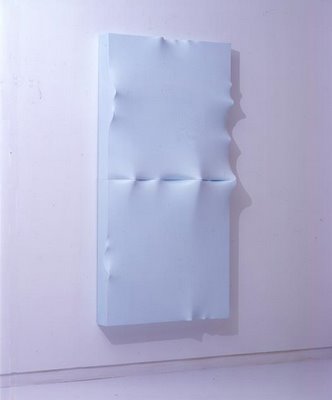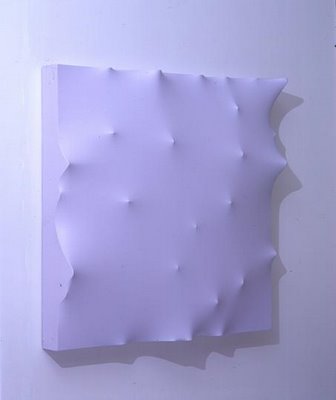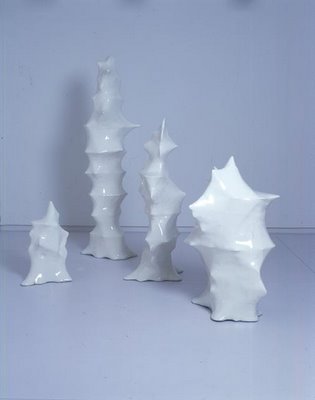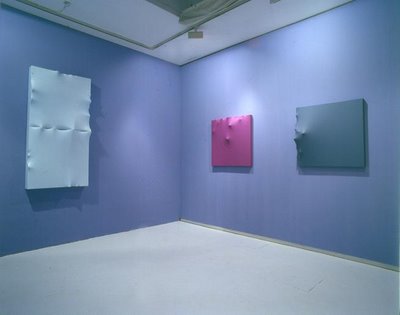Porfolio
1ª individual . Galeria Graça Brandão 2003





The Shapes’ Skin
Before I was confronted with the floor structures (let’s call them that) this text was going to be titled “the canvas’ skin”. In fact, the wall structures presented in this exhibition by João Galrão evoke a revolution in the painting’s surface remotely connected to Frank Stella’s shaped canvas or to Lucio Fontana’s cracked (and tom) canvas. In the first instance, the revolution was on the surface: the canvas did not resign itself to its rectangular condition, as if painting itself wanted to experiment other shapes and so multiplied (although in a rigorous and planned way) in the most convenient formal solutions, expanding but keeping its bi-dimensionality. In the second case, we can talk of a canvas own pathology: it cracks itself into a resolute cut of well-defined edges or it presents multiple perforations, as if showing its incapacity to contain the painting. It thus turns its disease into vitality, its fragility into force, as if the corporal offences it suffered, the incisive or obtuse wound, were now aesthetical and conceptual arguments. But in both cases the problem was decided on the surface, through a strategy of controlled expansion or through a strategy of incision, of perforation. The painter went beyond the square painting, amplifying it in more opportune configurations, or went beyond, to the other side of the canvas, going through its skin, tearing it.
In João Galrão’s case the problem is no longer one of the canvas passive response, reacting to an impulsive from the author, but a kind of mutiny of the canvas itself or, even better, of mutiny of an entity that hides behind the canvas. There is in these works a kind of third element, with an hidden body, which lives behind the painting and that, having stayed for a long time in an illusory sleep, all of a sudden woke up, started to stir an to push the canvas to the outside or sucking it inside. The canvas puts on volume, it no longer grows to the sides, it no longer tears but moves, denouncing that occult entity that is no longer capable of living in anonymity and is ready to emerge. The canvas become sculpture, even better, a wish of sculpture. The author’s monochromatic strategy is not indifferent to this wish. These monochromatic works, sometimes of very strong colours, reinforce the shape’s intension. Of burgeoning shape, the shape that pushes the surface to the outside of itself, transforming a horizontal plane into an undulated vertigo with multiple contours that reinforce its structural complexity.
This idea of art as the apprehension of a time to come, as the anticipation of a transformation, is particularly meaningful in the designation João Galrão found to name the floor structures. He called them “omens”, i.e. anticipations of the future, anticipations of transformation. The idea of transformation also recalls the situation of the unsatisfied form, the trans-form. The author is, thus the discloser of the mutiny of shapes. Or of the mutiny of surfaces that want to be shapes and of the shapes that at once hide and show that desire. His paintings want to be sculptures and his sculptures want to be figures (although, for now, they are only ghosts), in a continuous process of transformation of the surface in volume and of volume in movement. It is not thus anomalous that, looking at those acrylic volumes, we have the sensation we are in the presence of tied entities, muzzled that can all of a sudden crack that vitreous varnish that coats and shuts them.
It is by developing the concept of transitory form, of form with flexible skin, that the pertinence of this exhibition is patent. These works are, above all, manifestation of anxiety; they are, above all, the detection of a shape’s respiration that art always tried to discipline. That is why there is here, beyond the formal (even structural) surprise, a disquietness, a plastic dissatisfaction connected to the fact of these works being “omens”, as if the reality’s skin, the skin of the present, was close to bursting.
Paulo Cunha e Silva
Before I was confronted with the floor structures (let’s call them that) this text was going to be titled “the canvas’ skin”. In fact, the wall structures presented in this exhibition by João Galrão evoke a revolution in the painting’s surface remotely connected to Frank Stella’s shaped canvas or to Lucio Fontana’s cracked (and tom) canvas. In the first instance, the revolution was on the surface: the canvas did not resign itself to its rectangular condition, as if painting itself wanted to experiment other shapes and so multiplied (although in a rigorous and planned way) in the most convenient formal solutions, expanding but keeping its bi-dimensionality. In the second case, we can talk of a canvas own pathology: it cracks itself into a resolute cut of well-defined edges or it presents multiple perforations, as if showing its incapacity to contain the painting. It thus turns its disease into vitality, its fragility into force, as if the corporal offences it suffered, the incisive or obtuse wound, were now aesthetical and conceptual arguments. But in both cases the problem was decided on the surface, through a strategy of controlled expansion or through a strategy of incision, of perforation. The painter went beyond the square painting, amplifying it in more opportune configurations, or went beyond, to the other side of the canvas, going through its skin, tearing it.
In João Galrão’s case the problem is no longer one of the canvas passive response, reacting to an impulsive from the author, but a kind of mutiny of the canvas itself or, even better, of mutiny of an entity that hides behind the canvas. There is in these works a kind of third element, with an hidden body, which lives behind the painting and that, having stayed for a long time in an illusory sleep, all of a sudden woke up, started to stir an to push the canvas to the outside or sucking it inside. The canvas puts on volume, it no longer grows to the sides, it no longer tears but moves, denouncing that occult entity that is no longer capable of living in anonymity and is ready to emerge. The canvas become sculpture, even better, a wish of sculpture. The author’s monochromatic strategy is not indifferent to this wish. These monochromatic works, sometimes of very strong colours, reinforce the shape’s intension. Of burgeoning shape, the shape that pushes the surface to the outside of itself, transforming a horizontal plane into an undulated vertigo with multiple contours that reinforce its structural complexity.
This idea of art as the apprehension of a time to come, as the anticipation of a transformation, is particularly meaningful in the designation João Galrão found to name the floor structures. He called them “omens”, i.e. anticipations of the future, anticipations of transformation. The idea of transformation also recalls the situation of the unsatisfied form, the trans-form. The author is, thus the discloser of the mutiny of shapes. Or of the mutiny of surfaces that want to be shapes and of the shapes that at once hide and show that desire. His paintings want to be sculptures and his sculptures want to be figures (although, for now, they are only ghosts), in a continuous process of transformation of the surface in volume and of volume in movement. It is not thus anomalous that, looking at those acrylic volumes, we have the sensation we are in the presence of tied entities, muzzled that can all of a sudden crack that vitreous varnish that coats and shuts them.
It is by developing the concept of transitory form, of form with flexible skin, that the pertinence of this exhibition is patent. These works are, above all, manifestation of anxiety; they are, above all, the detection of a shape’s respiration that art always tried to discipline. That is why there is here, beyond the formal (even structural) surprise, a disquietness, a plastic dissatisfaction connected to the fact of these works being “omens”, as if the reality’s skin, the skin of the present, was close to bursting.
Paulo Cunha e Silva
Porto 2003

Scenes on the Life of Walls
It was a narrow corridor between white walls. At least, I recall the scene in black and white. From a certain moment on, the space between the walls starts to appear as disturbed, disturbing. The walls’ surface starts to gain life, as if behind the walls there were bodies with hands, breaths, respirations, threatening fingers. Chasings and harassments. Oscillations and involvements.
“Repulsion” is the title of the movie Roman Polanski directed in 1965 in the United Kingdom, where I might have seen a scene close to the one describe above. But ”repulsion” is not the right word, unless it is linked, indissociably, to a symmetric word such as, for instance, “attraction”. Repulsion and attraction, a mix with a considerable potential of voluptuousness. Maybe we could say the same thing in a simpler way just by talking of fear and temptation. Whichever words we choose, we know we are talking about potential physical effects of a seduction’s dynamics. Freddy Kruger, a famous character from horror movies, also dedicates himself frequently to make grow in walls, screens, steps, ceilings and sheets the most disturbing and frightening protuberances, threats and challenges. His objective, like a sculptor of souls, is to torment and seduce in dreams the objects of his favour. It is not by chance that one of Freddy’s most notorious quotes is his tempting appeal. “Come to Daddy!” On another occasion we will talk about the meanings of the word “daddy” in different contexts (see the sculpture “Big daddy”, 1999).
It may seem exaggerated that talking about works so clear, limpid and geometrical as seem to be (and are) João Galrão’s we start by talking about seduction processes.
João Galrão’s formation is in sculpture. Seduction cam in this case be the name of the relation between the body and the forms: the artist’s body, the observer’s body, the shape of the materials used as a base of the artist’s work (wood, canvas, stone, wool) and the shape of the final sheltering space of the works and how the observer circulates (a room, the walls in a room or in a corridor).
It is then a matter of embodying shapes and of shaping the body.
The mould, the negative of the mould, the tracing and the digital print are some of the most direct ways of this kind of procedures. João Galrão used them in an imaginative and experimental manner in many of his first works, where direct marks of body’s fragments were recognisable (see “Play Objects”, 1998) or there was an appeal to direct contact with the observer’s body (see “Nice Punish”, 1999).
Amongst the works now gathered for his first individual exhibition, João Galrão presents an ensemble of monochromatic canvasses stretched over wood gratings built with relieves as sculptural pieces.
At first glance they are abstract works, as even the basic shape is the square and the surfaces have a uniform colour. We should then evoke the geometrical abstraction, the tradition of the “monochrome” and the minimalism, and all theses reminiscences are pertinent.
But we can also recall that abstract art is the most concrete of all arts, because by aspiring to be the pure physical presence of form (disconnected from any intention of representation, with what representation implies of abstraction relatively to a reality to be represented) it ends up being the one most close to the statute of the body, perceived as a pure physical presence of a form. Especially if we consider the body as the place of a surface’s vertigo in whose epidermis all rigours and abysses of metaphysics and geometry fit.
We therefore come to a sensible paradox: João Galrão abstract paintings are concrete bodies.
In order to apprehend the pertinence of the conjunction between abstract and concrete or between geometry and sensibility we just have to recall, for instance, the way the Brazilian artistic vanguard of the 20th century second-half (Hélio Oiticica, Lygia Clark, Lygia Pape) evolved from neo-concretism, which could be seen as a variant of geometrical abstraction, to the elaboration of a vast and extremely rich repertoire of experiences in evocation and direct involvement of bodies. One only has to think, just to give a few examples, in Oiticica’s “penetrables”, in Lygia Clark’s “gloves” or in Lygia Pape’s “webs”.
João Galrão’s works embody shapes.
The canvas becomes another canvas, and the wall that receives the canvas, skin over skin, becomes a different wall, because over them passed a body that left its mark or, if one likes, the mark of its mark. The rhetorical mechanism of parting is here used to earmark the self-sufficiency of the work process specifically plastic/artistic that transforms what might have been the mere mark of a body into a self-sufficient aesthetical object, but one where, delicately, the symptoms of the passage of a body are still manifest. In he same way that in a body the symptoms of fever are still manifest, after it has gone, under the guise of a sensorial pacification, a cold sweat where the body rests, its trances forgotten, abandoned to the virtues of aesthetic or to sleep.
The room because a different one because the steps and the look of the visitor are now guided by the rhythm of the colours and undulation these works stamp in the space that receives them. It is a palpable tranquillity, a cosy but vibrating rhythm, where small explosions of surprising colours ensure a palpitating cadence. The sculptures, in the middle of the gallery, offer themselves as the visitor’s doubles, functioning as a physical counterpoint of his presence and orientating his movements.
João Galrão’s works give shapes to the body because, by escaping figuration, which is always a codification, open room for a clarity and distension exercise. The shapes develop before our eyes as the pacified territory of a preserved memory under a mute and obliging light. Memory of a sensuality of closed eyes where images were substituted by textures.
A geometry of caresses.
Alexandre Melo
Port, 2003
Scenes on the Life of Walls
It was a narrow corridor between white walls. At least, I recall the scene in black and white. From a certain moment on, the space between the walls starts to appear as disturbed, disturbing. The walls’ surface starts to gain life, as if behind the walls there were bodies with hands, breaths, respirations, threatening fingers. Chasings and harassments. Oscillations and involvements.
“Repulsion” is the title of the movie Roman Polanski directed in 1965 in the United Kingdom, where I might have seen a scene close to the one describe above. But ”repulsion” is not the right word, unless it is linked, indissociably, to a symmetric word such as, for instance, “attraction”. Repulsion and attraction, a mix with a considerable potential of voluptuousness. Maybe we could say the same thing in a simpler way just by talking of fear and temptation. Whichever words we choose, we know we are talking about potential physical effects of a seduction’s dynamics. Freddy Kruger, a famous character from horror movies, also dedicates himself frequently to make grow in walls, screens, steps, ceilings and sheets the most disturbing and frightening protuberances, threats and challenges. His objective, like a sculptor of souls, is to torment and seduce in dreams the objects of his favour. It is not by chance that one of Freddy’s most notorious quotes is his tempting appeal. “Come to Daddy!” On another occasion we will talk about the meanings of the word “daddy” in different contexts (see the sculpture “Big daddy”, 1999).
It may seem exaggerated that talking about works so clear, limpid and geometrical as seem to be (and are) João Galrão’s we start by talking about seduction processes.
João Galrão’s formation is in sculpture. Seduction cam in this case be the name of the relation between the body and the forms: the artist’s body, the observer’s body, the shape of the materials used as a base of the artist’s work (wood, canvas, stone, wool) and the shape of the final sheltering space of the works and how the observer circulates (a room, the walls in a room or in a corridor).
It is then a matter of embodying shapes and of shaping the body.
The mould, the negative of the mould, the tracing and the digital print are some of the most direct ways of this kind of procedures. João Galrão used them in an imaginative and experimental manner in many of his first works, where direct marks of body’s fragments were recognisable (see “Play Objects”, 1998) or there was an appeal to direct contact with the observer’s body (see “Nice Punish”, 1999).
Amongst the works now gathered for his first individual exhibition, João Galrão presents an ensemble of monochromatic canvasses stretched over wood gratings built with relieves as sculptural pieces.
At first glance they are abstract works, as even the basic shape is the square and the surfaces have a uniform colour. We should then evoke the geometrical abstraction, the tradition of the “monochrome” and the minimalism, and all theses reminiscences are pertinent.
But we can also recall that abstract art is the most concrete of all arts, because by aspiring to be the pure physical presence of form (disconnected from any intention of representation, with what representation implies of abstraction relatively to a reality to be represented) it ends up being the one most close to the statute of the body, perceived as a pure physical presence of a form. Especially if we consider the body as the place of a surface’s vertigo in whose epidermis all rigours and abysses of metaphysics and geometry fit.
We therefore come to a sensible paradox: João Galrão abstract paintings are concrete bodies.
In order to apprehend the pertinence of the conjunction between abstract and concrete or between geometry and sensibility we just have to recall, for instance, the way the Brazilian artistic vanguard of the 20th century second-half (Hélio Oiticica, Lygia Clark, Lygia Pape) evolved from neo-concretism, which could be seen as a variant of geometrical abstraction, to the elaboration of a vast and extremely rich repertoire of experiences in evocation and direct involvement of bodies. One only has to think, just to give a few examples, in Oiticica’s “penetrables”, in Lygia Clark’s “gloves” or in Lygia Pape’s “webs”.
João Galrão’s works embody shapes.
The canvas becomes another canvas, and the wall that receives the canvas, skin over skin, becomes a different wall, because over them passed a body that left its mark or, if one likes, the mark of its mark. The rhetorical mechanism of parting is here used to earmark the self-sufficiency of the work process specifically plastic/artistic that transforms what might have been the mere mark of a body into a self-sufficient aesthetical object, but one where, delicately, the symptoms of the passage of a body are still manifest. In he same way that in a body the symptoms of fever are still manifest, after it has gone, under the guise of a sensorial pacification, a cold sweat where the body rests, its trances forgotten, abandoned to the virtues of aesthetic or to sleep.
The room because a different one because the steps and the look of the visitor are now guided by the rhythm of the colours and undulation these works stamp in the space that receives them. It is a palpable tranquillity, a cosy but vibrating rhythm, where small explosions of surprising colours ensure a palpitating cadence. The sculptures, in the middle of the gallery, offer themselves as the visitor’s doubles, functioning as a physical counterpoint of his presence and orientating his movements.
João Galrão’s works give shapes to the body because, by escaping figuration, which is always a codification, open room for a clarity and distension exercise. The shapes develop before our eyes as the pacified territory of a preserved memory under a mute and obliging light. Memory of a sensuality of closed eyes where images were substituted by textures.
A geometry of caresses.
Alexandre Melo
João Galrão links:
www.joaogalrao.blogspot.com
www.joaosintra.multiply.com
www.myspace.com/joaogalrao
http://projecto-afrontamentos.blogspot.com
http://afrontamentos.multiply.com

1 comment:
É sempre bom ver o nosso trabalho divulgado, o que desde já agraçeço e fico grato.
Tambem criei um grupo no multiply para artistas do second life,é o www.slimproject.multiply.com.
Errata: Em vez de ler "Luso Long" ler Luso Lounge.
cumprimentos, abraços
joao galrao
Post a Comment